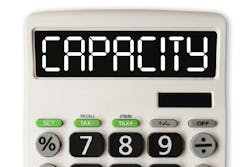Knowing your shop production capacity is key to avoiding bottlenecks and maximizing the number of jobs that can profitably be completed each day. By understanding your shop’s production capacity, you can work to fix process flaws and maximize sales.
Tony Monaco, a business development manager at FinishMaster, regularly helps shops find their maximum throughput. Monaco discusses how to calculate your shop capacity and the various factors that need to be considered.
It’s a good idea to have a basis of how much your shop can handle. It can help you identify bottlenecks, staffing issues or process flaws. The challenge when we talk capacity is that there’s the physical capacity of the building and then there’s the manpower side of it. So when I’m calculating shop capacity, I look at both of those and then combine them to find the true shop capacity.
To calculate the physical capacity, I start by using the latest industry multipliers determined by KPIs. There are ranges because of differences in markets, labor rates and your own facility, but as a starting point, this is generally what it looks like:
Square feet x $23 to $30 = Monthly sales per total square feet
Productive square footage x $20 to $27 per month = Monthly sales per productive square foot (To measure the productive square foot, use a roller measurer)
Number of stalls in use x $24,000 to $26,000 = Monthly sales per stall
Number of employees x $16,000 = Monthly sales per employee
Number of production employees x $25,000 = Monthly sales per production employee
Now you have about four or five numbers showing shop capacity based on productive square footage, stalls and employees. I take those numbers and average them to give me a theoretical capacity.
Now we will look into the processes and the manpower. If a shop says they need to get more cars through, we will do a process analysis. I like to go into a shop, walk around, look at how the space is used (How are parts being handled? Is there a cooldown area for paint? Are you doing a complete teardown? Are booths drive-through?), take pictures and talk to the techs. I like to understand what the shop’s goals are, so I can help them understand what kind of manpower they’re going to need and what kind of footprint they’re going to need.
What we often see is that teardown, parts ordering and parts handling are the biggest issues in the industry right now. There is a lot of dead space in shops. There’s a project car in the corner, the parts get dropped off and nobody is mirror-matching them. Once you have the calculated number we discussed above, that typically calls out the issues your shop needs to fix. For example, if you got parts carts and put the parts on carts, that extra floor space could translate to another car in the shop.
It’s really about the processes in the shop. If you ask most people, they would say they want their techs to have two stalls. But if you have five body techs and they have 10 stalls total, 50 percent of your shop is always being unused. Is that really the best way to run the shop? If you look at touch time, what is the average touch time on the car per day? That will bring us back to processes. Maybe you need a heavy-hit stall so that crippled cars aren’t just sitting in your shop taking up space. Or maybe the parts ordering process is taking up too much time, which is why we thought the techs needed two stalls. You don’t need to take up all that square footage.
There are also some blatant reasons a shop could be maxed out. If you have a bottleneck in the paint shop, for example, and the reason is that your primer isn’t drying fast enough, try priming vehicles the night before.
What I’m getting at is that it’s not enough just to calculate the shop capacity. Once you do that, you really need to dive into your processes and analyze if you’re operating at your most efficient. The numbers will tell you if you are, but there are probably several easy fixes that could impact your production capacity.



